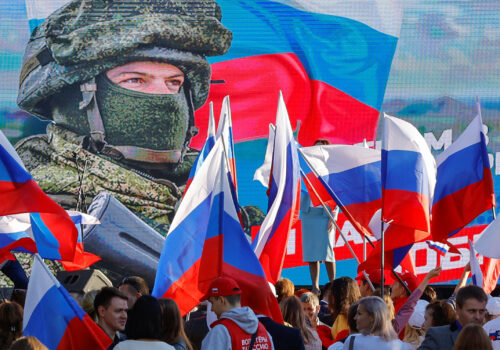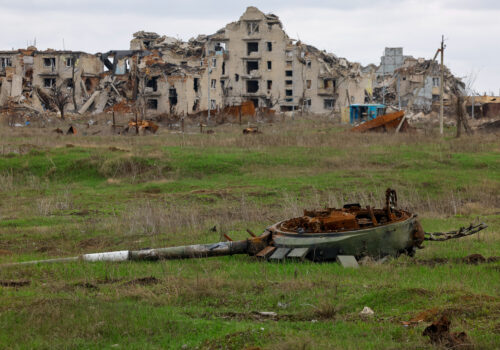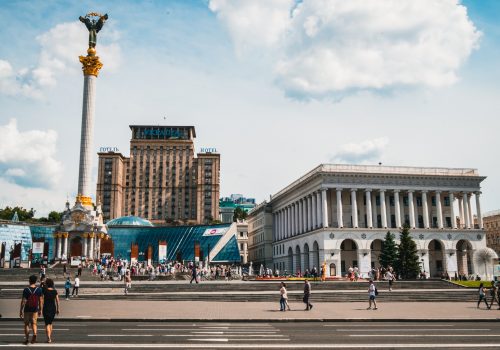Cut the cameras. Slash the salaries. Cancel the investigations. That’s the reality facing Ukraine’s independent media, which serves as a vital firewall against Kremlin disinformation, as the US freezes nearly all support.
Since January 2025, the United States has quietly suspended 90 percent of its development funding for Ukraine, including the grants that kept most of the country’s independent newsrooms alive. Whether channeled directly through USAID or via partners, that funding has disappeared. The move to cut financial support comes as Moscow is intensifying its disinformation efforts.
In Mykolaiv, a strategic port city in Ukraine’s south, NikVesti is on the brink. With 4.5 million visits in 2024, it has been a cornerstone of independent local wartime reporting. Now, after losing a fifth of its budget through the loss of US funding, the newsroom is running on fumes. “We’re burning through our final reserves,” co-founder Oleh Dereniuha commented. “If funding doesn’t return, it will be difficult to make it past April.”
Further south in Kherson, Vgoru, one of only three independent outlets still operating in the region, has lost 80% of its US funding. Freelancers are gone and investigative projects have been shelved. “No one else is reporting from here,” said editor Ilona Korotitsyna. “Without us, they’ll only hear Russia.”
In Sumy, a northeastern Ukrainian city facing relentless Russian bombardment from across the nearby border, independent outlet Cykr is barely hanging on. “Sixty percent of our budget came from USAID,” said editor Dmytro Tyschenko. The site has enough funding to last a month. “After that,” he warned, “we’re bracing for a flood of unchecked Russian propaganda to fill the vacuum.”
Stay updated
As the world watches the Russian invasion of Ukraine unfold, UkraineAlert delivers the best Atlantic Council expert insight and analysis on Ukraine twice a week directly to your inbox.
Since Russia’s full-scale invasion began in 2022, the US has delivered more than $37 billion in development aid to Ukraine. With the domestic Ukrainian media market in a state of wartime collapse, the vast majority of outlets have survived almost entirely on international grants, most of them from the US.
Outlets like NikVesti, Vgoru, and Cykr are among the 90 percent of independent Ukrainian media that relied on this funding to report the facts under extraordinary conditions of bombardment, blackouts, and occupation. Beyond exposing Russian disinformation, journalists working for these outlets have investigated corruption, documented Russian strikes and their aftermath, and held the Ukrainian authorities to account, often at considerable personal risk.
There are now mounting concerns that Russia will seek to exploit emerging gaps in Ukraine’s information space created by US funding cuts. With far fewer credible sources able to report on local news stories across Ukraine, Kremlin disinformation will become much harder to counter.
Eurasia Center events

A recent disinformation operation in the Sumy region offered a glimpse of the kinds of tactics Moscow is likely to employ. In early April, Russian-linked Telegram channels began promoting fake messaging attributed to the Sumy City Council’s Health Department claiming that a mysterious disease had broken out among Ukrainian soldiers. They warned civilians to avoid contact with troops returning from the front.
This is a typical Russian disinformation operation, with fake news wrapped in official-looking packaging and seeded online in order to sow panic. The goal isn’t just to mislead, however. Russia also aims to undermine faith in the information space altogether. And with credible independent Ukrainian media outlets unable to operate, that task becomes significantly easier.
Allowing Ukraine’s independent media to fall silent in the middle of a war would have serious strategic consequences. Without independent journalism, Ukraine not only loses its first line of defense against Russian disinformation. It also loses the transparency and accountability that are vital for the future of the country’s democracy.
The Ukrainian outlets and journalists hit by recent US funding cuts are not just waiting for a bailout. They are launching membership programs, pitching donors, trimming operations, and testing new formats. Some are turning to diaspora networks. Others are banking on European funding. So far, these efforts are proving slow and insufficient.
“We’re doing everything we can. In a region where the local business market is nonexistent, we’re reaching out to European partners, applying for every grant we can find,” said Vgoru’s Korotitsyna. “But EU funding is slow, and the competition is fierce. We need support now, not six months down the line, or we won’t be around to receive it.”
Muhammad Tahir is a nonresident senior fellow at the Atlantic Council’s Eurasia Center and a former journalist with Radio Free Europe/Radio Liberty. He has reported extensively across the CIS, South Asia, and the Middle East.
Further reading
The views expressed in UkraineAlert are solely those of the authors and do not necessarily reflect the views of the Atlantic Council, its staff, or its supporters.

The Eurasia Center’s mission is to enhance transatlantic cooperation in promoting stability, democratic values, and prosperity in Eurasia, from Eastern Europe and Turkey in the West to the Caucasus, Russia, and Central Asia in the East.
Follow us on social media
and support our work
Image: Kyodo via Reuters Connect





